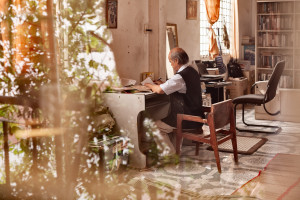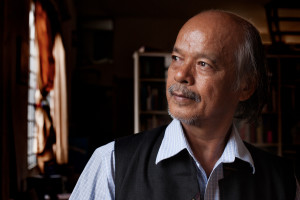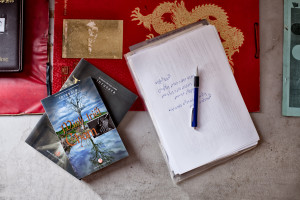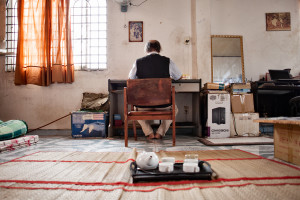Written by Zelda Rudzitsky. Photos by Lee Starnes
Saigoneer, Published on Tuesday, 09 August 2016 15:12

Born in the oldest Cham village in Vietnam, poet and literary critic Inrasara has been keeping Cham literature alive for over 30 years. From textbooks to poetry, literary criticism to publishing, the accomplished literary jack-of-all-trades discusses the preservation of his culture, the challenge that launched his impressive career and the state of contemporary Vietnamese poetry today.
Within the world of Vietnamese literature, poets from ethnic minorities occupy a special place. While their work is certainly not mainstream, their status as minority citizens affords them a certain freedom: these poets are less compelled to fit in or even follow the standard poetic styles and tropes of Vietnam’s rich and ancient pantheon of national poetry. On the contrary, such poets are often encouraged to talk about their own distinct cultures and languages in an attempt to bridge the economic and cultural gaps between different communities within Vietnam.
It is this space which Cham poet Inrasara has dominated for over three decades. Born in Ninh Thuan province’s Caklaing hamlet, the country’s oldest Cham village, Phu Tram – better known as Inrasara – began writing at age 15. Shortly thereafter, he was selected to assist the provincial government in creating educational books on Cham language.
“At that time, among young Cham people, I was very famous for [my work on] Cham language,” he tells Saigoneer. “Because of this, I was invited by the Department of Cham Textbooks in Thuan Hai province [now separated into Binh Thuan and Ninh Thuan provinces] to work for them.”
A blend of literary criticism (Female Poets in the Journey to Cut the Suffix ‘Female’), prose (Nhung Cuoc Di Va Cai Nha /The Journeys and the House) and educational textbooks, including a Cham-Vietnamese dictionary, his later efforts have focused on the study and research of Cham culture as well as the composition of poetry steeped in Cham folklore, history and literary traditions.
In 1978, after leaving the University of Pedagogy in Ho Chi Minh City, Inrasara traveled to Cham villages to collect folk stories and immerse himself in philosophy, particularly the work of German philosophers such as Nietzsche and Heidegger. The bilingual Cham-Vietnamese poems written during this period of his life highlight Cham teachings and philosophy.

It all started as something of a challenge.
“When I was 15, I read something by [the] French author Paul Mus,” he explains. “He said that there is nothing in Cham literature and that he could summarize it in a few pages. I obviously disagreed with him so I went on to research about the history of Cham literature. This is one of the oldest languages in Southeast Asia, and it dates back to the fourth century. By 1995 and 1996, I had written three books – a total of 5,000 pages – related to Cham literature to disprove Mus. If Kazik was responsible for the restoration of the Cham sanctuary of My Son, then I am responsible for the restoration of Cham literature.”
Not a few friends have scolded me for wasting time on Cham poetry
is there even a trifling scarcity of readers? Will there be anyone to remember?
yet I want to squander my entire life on it
though there may only be around a quarter dozen people
though there may only be one person
or even if there’s not a single living soul!
(An excerpt from “Allegory of the Land”, translated by Alec G. Schachner).

“The alarming thing is that Vietnamese literature does not have space for Cham literature,” says the Saigon-based poet. By merging Cham and Vietnamese, Inrasara manages to recreate images from Cham folklore as well as balance the poetic sounds of both languages and their respective literary traditions. Although the two languages differ in structure, Inrasara’s thoughtful, measured use of both Cham and Vietnamese makes both “worlds” accessible and comprehensible to readers familiar with neither Cham nor Vietnamese poetry and culture. In his award-winning book The Purification Festival in April, he inserts Cham vocabulary, while in other poems he writes in Vietnamese and then translates the work into Cham or vice versa. This fluidity of language comes naturally to the poet.
“Most Cham minorities live in the south-central and Delta regions of Vietnam, and they are not as separated as other minorities,” Inrasara says. “We learn the Vietnamese language at a very young age so incorporating Vietnamese within the Cham language is not difficult.”
Still, though Inrasara and many of his fellow Cham are comfortable in the two languages, their differences are stark. Cham script comes from Sanskrit, while its vocabulary belongs to the Austronesian family of languages. Vietnamese, on the other hand, is known as an Austroasiatic language with Chinese derivations. Despite their drastic differences, Inrasara moves between the two seamlessly in an effort to retain the meaning of individual words in both languages.
“When writing poetry, the biggest difference is that Vietnamese has many monosyllabic words while Cham tends to have more multisyllabic ones,” he explains. “When I insert Cham words in a poem, I try to retain the imagery that they convey as well as the overall rhythm of the poem.”
The survivor does not have time for literature
an open sky to breathe
no dream of erecting renown
a house to reside.
•
From this house
I was born and brought up
I grew to know metaphysics, practiced writing literature
I will not forget you father, not forget myself
still enough time to contemplate metaphysics, to create literature
enough time to ponder carefully, write lengthily
ten times a hundred times a thousand times longer than Pauh Catwai, Glang Anak.
(An excerpt from “Allegory of the Land”, translated by Alec G. Schachner).

Within his work, the poet’s own personal narratives echo back to his people’s ancient stories.
“[The poem] refers to the remaining survivors of the Champa,” explains Inrasara. “In 1832, Minh Mang suppressed the Cham people so they fled to the mountains or to Cambodia. In 1842, King Thieu Tri asked them to come back but by then the population had shrunk to around 5,000 individuals. That’s the environment I grew up in, since this is linked to my ancestors and it is my heritage. I always put my own personal narrative in my poems but one that resonates with others.”
Through his work as a magazine editor, researcher and literary critic, Inrasara has also challenged the clichés of accepted Vietnamese poetry and style, as he points out when we talk about the state of contemporary poetry, and in particular, about a controversial group of young Vietnamese writers known as Open Your Mouth. The quartet uses common slang, sexual innuendo and a plethora of swear words to challenge the notion of poetry as a sophisticated and cultured literary pursuit.
“What [Open Your Mouth] did comes from a non-mainstream form of writing. I’m very sympathetic with their intentions because their use of language is a very good way for people to approach poetry,” says Inrasara. “People think that poetry should be elegant, highbrow and sophisticated, but for me it’s more about connecting to common life. What they wrote could be given to… anyone and it would be understood.”
However poetry within Vietnam remains very traditional, following the form and function of previous generations of writers. The country’s more innovative poets tend to seek out audiences abroad.
“The media has been saying that Vietnamese poetry doesn’t have a big audience and that it is nonsensical because [the media’s response to Vietnamese poetry] lacks social and political commentary,” says Inrasara. “In my opinion, there are three main groups of poetry in the country but only two are accepted. The first one is the more traditional while the second group, innovative poetry, which is more recent, tries to renew poetry only in the form but not in the content…The third group is exploratory poetry, which includes post-modern poetry, feminist poetry, New Formalism poetry and performance poetry.”
Meanwhile, ethnic minority literature, which Inrasara says is far more accepted in Vietnam, tends to receive more support than some of the country’s less traditional schools of contemporary poetry. As these unconventional works and the poets behind them continue to inch their way toward recognition in Vietnam’s larger literary pantheon, Inrasara stays his own course, pulling Cham culture, history and literature into the present and disproving Mus’ claims time and again as he goes.

Getting you up there right first time in digital marketing is our motto…!!